- Home
- About
-
Shop
-
Sewing Patterns
-
Fabric
- Sewing Supplies
- Folkwear Clothing
-
- Blog
- Customer Gallery
- Contact
November 24, 2023
Folkwear's annual Black Friday Sale goes until Sunday the 26th (midnight EDT)! Use code THANKS2023 to save 25% on all sewing patterns, fabric, and sewing supplies. And, just in time for the sale, we got some exciting new fabrics in recently. I will show you the some of these new fabrics and will give suggestions for what Folkwear patterns they will be great for. These fabrics are beautiful and very fitting for winter, and some are well suited for the coming spring season. If you want to get some fabric for sale, today through Sunday would be a great time, especially while we still have these gorgeous fabrics in stock. Don't forget that we sell our fabric by the 1/2 yard, so each unit is 1/2 yard (2 units is 1 yard, etc.).
We ordered several colors of these stunning wool/linen woolsey fabrics from Merchant & Mills. I've been eyeing them for years and now that they will soon be discontinued, we decided to wait no longer to get them in stock. These fabrics would look amazing for long skirts, light weight jackets, shirts, pants, or simple dresses. They are soft with a nice drape, and have different colors on each side of the fabric. I can imagine this used for 216 Schoolmistress Skirt, 148 Black Forest Smock, Basics Overcoat, or a pair of pants or overalls from 240 Rosie the Riveter. Both sides having pretty color would also make it a wonderful fabric for the 271 Sunset Wrap (which also makes a great gift). These woolseys would also be beautiful in 270 Metro Middy Blouse, 209 Walking Skirt, or 233 Glamour Girl Dress. And for pants, these patterns would be great: 119 Sarouelles, Basics Pants, 250 Hollywood Pants, 112 Japanese Field Clothing.
This fabric also comes in a dark burgundy, teal and a dark brown color.

Woolsey Wool Linen blend - Black Coffee

Wool Linen blend Woolsey - Oxblood
We still have some beautiful Italian Wool in stock. This Italian Yarn Dyed Wool is very soft and lightweight (like a suiting weight) with a beautiful glow of muted warm colors. Use it for 256 At The Hop, 209 Walking Skirt, 233 Glamour Girl Dress, 222 Vintage Vests, 132 Moroccan Burnoose. I think it would be really cute for 251 Varsity Jacket and for 123 Austrian Dirndl as a warmer dress.
I really missed having lots of sanded twill options in our collection, so we ordered more! Our new stock is bright, fun, and rich in color. Get ready for this bright orangey-red color called Chore Red!
I think these colors are fantastic, and I think sanded twill is the best! I really want someone to make 231 Big Sky Riding Skirt out of these twills or even something from 240 Rosie the Riveter, 229 Sailor Pants, 126 Vests from Greece and Poland, 270 Metro Middy Blouse, or the Basics Pinafore Dress.
I am definitely buying some of this green sanded twill fabric during our sale. It would be classic for 130 Australian Bush Outfit. I would love it for 230 Model T Duster and 231 Big Sky Riding Skirt. This slightly heavier twill would work nicely for 133 Belgian Military Chef's Jacket, 242 Rodeo Cowgirl Jacket or 243 Rodeo Cowgirl Skirt - PDF.
Also, any of the twills would be great as cushion covers, durable and easy to clean, try it with 305 A Japanese Interior.

Cotton Sanded Twill - Chore Red

Sanded Twill - Otto Green (12oz)
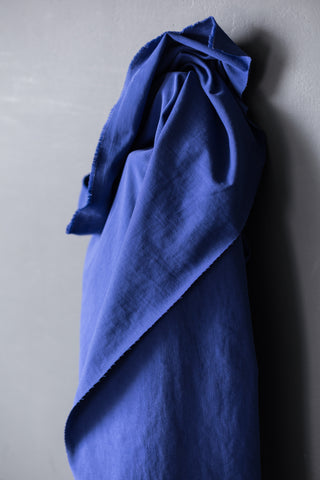
Cotton Sanded Twill - Prussian Blue
We also got in quite a few Jacquard Cottons from Merchant & Mills, including some new ones. These jacquard fabrics are made up of layers of cotton, with a jacquard weave that gives it a quilted look and feel. They are actually quite warm. I've made a pair of sweatpants from a grey Jacquard we have and wear them on really cold days. These fabrics below would fit well with 305 A Japanese Interior, 206 Quilted Prairie Skirt - PDF, 106 Turkish Coat, 138 Child's Australian Drover's Coat. Molly made the 137 Australian Drover's Coat for herself out of our quilt-like Jacquard, check the blog post here. You can also see the 206 Quilted Prairie Skirt she made from one of the jacquards in this post as well. These fabrics are great for bedding as well - Molly has a beautiful blanket she made with a length of this fabric - bound on each end with a pretty binding she made with scraps of Liberty of London lawn.


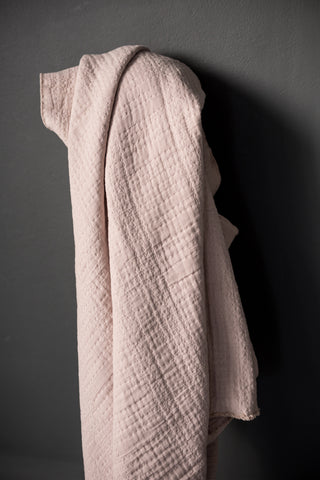
This layered cotton has a jacquard weave, with fine cotton on top, no batting in the middle of this cloth, the inside is made up of a series of thicker yarns and the reverse is a gauzy cotton.

Marine Blue Jacquard Cotton - Merchant & Mills
We also have these two Viscose Challis vintage floral print fabric. They are very soft and lightweight. They would be perfect for vintage inspired garments like the 252 Beach Pyjamas, 510 Passionflower Lingerie, 241 Fifties' Fit and Flair, 247 Lindy Shirtdress, or 205 Gibson Girl Blouse.

Viscose Challis - Vintage Teal Floral Print

Viscose Challis - Olive Vintage Floral Print
These are only a few of our new fabrics, so go ahead and get shop our fabric while it is on sale! Christmas is coming up so it would be a good time to get some handmade gifts ready! Check out our gift guides from years past: last year's gift guide, gifts to be sewn, and 2021 gift guide.
Enjoy shopping and have a wonderful time with your loved ones!
November 21, 2023 2 Comments on How to finish the 223 A Lady's Chemise neckline with lace eyelet
by Esi Hutchinson
Hello! I hope you saw Folkwear's blog post I wrote about making the 223 A Lady's Chemise into a blouse. If you have not read it you can check it out here. Recently, I made another chemise to add to the Folkwear sample collection. We wanted a sample that was made of an organic white cotton voile -- a more authentic, or traditional/historic, version. We used View A, which is a bit off the shoulders (though can also be worn wide on the shoulders). Traditionally, the chemise was an undergarment made of light to medium weight cotton or linen and was often white. The lace and eyelet/beading was used to finish the neckline and sleeves openings and add a bit of a romantic touch. For this chemise, I used an eyelet lace that we already had in our stash, and the voile from our fabric collection.
Our eyelet lace already had the ruffle attached (it was eyelet/beading and lace in one!), so I had to modify the instructions to finish this chemise. The instructions have the neckline and sleeves finished with a bias binding, eyelet or beading, and a lace edging - all of which come together to provide a clean and romantic finish. We imagine that often times, you use the notions, like lace or eyelet, that you have in your stash (or have inherited). So when you go to make a garment like this one, you look at what you already have, especially if it is inherited or heirloom pieces. And this means that what you have on hand might not be exactly what the pattern is calling for. As in this case. So, you have to modify how the neckline and sleeves are finished so that you get the look you want with the pieces you have. I will show you how I assembled this eyelet lace to the neckline, and maybe that can help you in a similar situation.

Close up of the eyelet (beading) lace used.
The cotton voile I used is very lightweight so I finished all the seams with French seams. This seam finish is authentic, and it also looks more professional in my opinion. It also really gives the garment an heirloom-quality feel. French seams are also good to use with delicate fabrics like this voile. Here is a blog post on our site you can refer to if you don't know what and how to use a French seam: How to Sew a French Seam.
 French seam on the inside side of this chemise.
French seam on the inside side of this chemise.Adding the Lace
Instead of first sewing on the eyelet lace (which is also called beading in the instructions), I first sewed on the bias binding like the instructions say. The eyelet I use is finished on each side with lace, so I did not need to "sandwich" it with the binding and lace edging.
I trimmed the seam allowance and pressed the binding away from the bodice, and turned it to the inside. Then I topstitched the pressed edge of the binding through all layers. This finishes the raw edge of the bodice. I did the same to the sleeves.
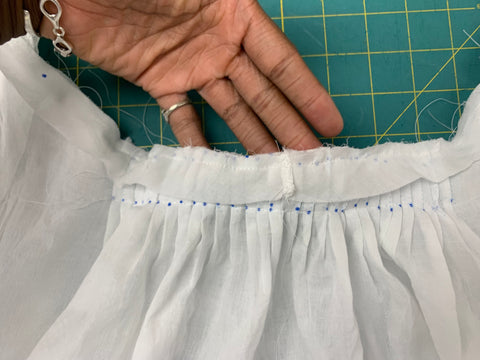
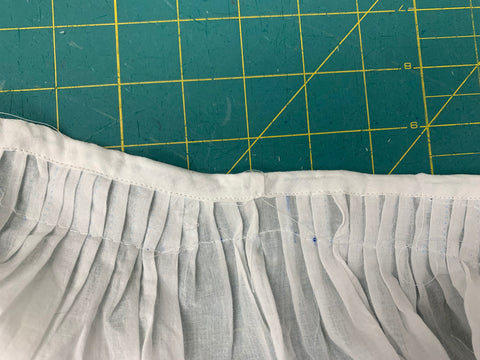
I pinned the eyelet lace so that the inside edge of the lace (where the eyelet changes to lace edging) was about 1/8" (3mm) from the top edge of the bias binding. I stitched the lace down on that line. And I did the same for the sleeves.

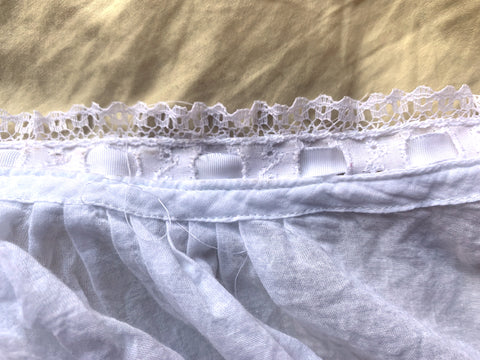
Inside the chemise. You can see the stitching line about 1/8" from the top of the bias binding where the eyelet lace is stitched down.
 VOILA! Finished!
VOILA! Finished!
You can purchase ribbon to weave through the eyelet or make your own using a binding tape maker and fine fabric. I used a satin store-bought ribbon for this sample. I finished the ends of the ribbon by turning them under twice by 1/4" (6mm) and stitching.
I have a few more pictures of the finished 223 A Lady's Chemise (View A) below. This was a fun project and I enjoyed looking through our lace collection to find something that worked for this chemise.



November 17, 2023 2 Comments on Pants from 240 Rosie the Riveter pattern
by Molly Hamilton
I have been wanting to make a pair of wide leg pants for a year now, ever since I bought a pair I loved at a boutique in Asheville last winter. They were so comfortable and easy and fun to wear, that I knew I needed to make another pair for myself. I also knew that we had the perfect pattern in Folkwear's collection. Our 240 Rosie the Riveter has a great pair of wide leg trousers that have plenty of room, nice pleats, and back darts. I really love this 240 Rosie the Riveter pattern. The overalls are very cute, the shirt is wonderful (just make it a size or two smaller than you might think), and I also really love the dress that can be made from the overalls pattern, which is taught in the blog post and not actually part of the pattern. But, I hadn't made the pants yet. So two weeks ago, I made myself a pair of pants!
For fabric, I was first interested in a Tencel twill in a dark color, but the only Tencel twill we had in stock was an aqua. But, I also really like our sanded twills and we had quite a bit of a khaki green color, so I decided to use that. We now have several more colors of sanded twills, and if you are interested you can see them here.
For sizing, I am between the Folkwear sizes Small and Medium for waist and hips. I measured the waistband and felt that the medium size would be most comfortable and fit just right at my waist. There is little to no ease in the waist, but plenty of ease in the hips. I made a muslin to decide if I wanted to make any other adjustments.

There is a lot of room in the crotch of these pants. The crotch is very low and this allows plenty of room in the seat area for moving, squatting, and sitting (as you might be doing if you were working putting together tanks in a factory in the early 1940s). But, I didn't feel I needed or wanted quite so much room. So I raised the crotch in the front and back by 1/2" (13mm). That isn't a lot and I could have done a little bit more, but it was perfectly fine for me and made the fit better. I used our tracing fabric for tracing the pattern and making adjustments, as you an see below.

I also shaved off a little (maybe 1/4"-1/2" (6-13mm)) at the side seams near the hip. I also know that I usually need to increase the length of the legs of our patterns for myself, so I added 1" in length to the leg. These pants have a very straight leg (pattern was folded below, so it looks a little wonky, but it truly is straight!), so lengthening and shortening can be done at the bottom of the leg.

The only thing that was really different from the ready-to-wear pair I bought was that the Rosie pants have a back zip and button rather than a front fly. Since I don't love making a front fly, especially if I have to draft it myself, I decided the back zip was perfectly fine for my own pants. And honestly, I think I like it better! The front is flat and comfortable. Instead of a button in the back as the pattern indicates, I used a hook-and-eye closure, which I also liked better and found it easier to use.


I really like these pants! They will be a wardrobe staple this fall and winter. Note, the shirt I am wearing here is made from our white handkerchief linen and is made with the 212 Five Frontier Shirts (classic view without the decorative yokes). Now I want to make another pair, maybe in a fabric with a little more flow (like a Tencel twill).



November 09, 2023 7 Comments on How I made 223 A Lady's Chemise into a Blouse!
by Esi Hutchinson
When it comes to lingerie, there are countless options to choose from. And Folkwear has been exploring our own designs of lingerie this year in particular, with our new 1950s-inspired patterns 510 Passion Flower and 511 Juliette's Dream. We also have the Edwardian 226 Princess Slip which makes great nighttime wear but could also be made for a more formal outing in my opinion. I've been thinking about making it recently into an everyday dress, so maybe I'll tackle that project soon. And lots of other vintage lingerie, undergarments, and nighwear patterns can also be great modern day daywear. However, this blog post will show you how I made another one of Folkwear's undergarment patterns into a blouse from the 223 A Lady's Chemise.
Folkwear's 223 A Lady's Chemise pattern is based on chemises that were worn in the mid- to late-1800s. Chemises were originally worn right next to the skin as a simple, practical garment to protect outer clothing (including corsets and stays) from sweat and body oils. However, over time, they evolved into a fashionable and seductive lingerie item. This vintage dress still resonates in style today, with baby doll style dresses, tops and lingerie with beautiful lace and bows.
Our chemise is a loose-fitting undergarment that can be made into a blouse or a dress, falling to whatever length you desire. It makes a great nightdress or a dress for everyday wear. I made a blouse and will show you the changes I made so that you can do it too!
Typically, the chemise was made from lightweight and breathable fabrics such as cotton lawn, voile, silks, lightweight muslin, and linen. For our pattern, you also need eyelet beading, lace or eyelet ruffles to finish and embellish the neckline and sleeves.
Folkwear suggests using silks, like crepe de chine and charmeuse, which would give it such a beautiful and luxurious look and feel (I don't know who doesn't love silk). Satin, cotton, or rayon challis and other lightweight fabrics such as batiste, lawn, voile, gauze, eyelet, and handkerchief linen would also work well. We recently have been loving our new cotton/linen blends from Merchant and Mills, its a great substitute for linen or cotton that would work really well. Our cotton voiles and Indian cotton are also light and breathable and would suit this garment as well. For this shirt, I used our cotton/linen blend in Blackberry. It is a bit hard to tell on the screen, but this fabric is woven like a chambray and looks different at different angles. It is very pretty! Check out or fabric collection, I am super proud of it right now, we have so many options and I just want to buy everything for myself.
Now to show you how I made this pattern into a shirt for myself. Not only did I shorten the pattern to make a blouse, I made some design changes as I went that were fun and gave me a look I was really pleased with. I love using my creativity when sewing to take a fabulous pattern and make it perfect for me (and you should too!). Lets begin!
Cutting the Pattern and Tracing the Pleats
First, I traced the pattern in a size small. I wanted to make a shirt-length top, not a dress-length garment, so I shortened the front and back by cutting the pattern about 18.5" (47cm) from the top of the center front/back on the pattern piece (I did not use the lengthen/shorten lines, but you could!). The other thing to know about this pattern when starting, is that the front and back are cut and pleated, and then they are cut again after pleating to make the neckline (after the pleats are basted). This is to make the tiny pleats easier to manage. But it also gives you some flexibility about where you want your neckline to fall.
 I traced my pattern on tracing fabric (and to get the most out of this fabulous sewing product, we often tape sections together of previously used pieces to get full pattern pieces).
I traced my pattern on tracing fabric (and to get the most out of this fabulous sewing product, we often tape sections together of previously used pieces to get full pattern pieces).
There are a LOT of pleat lines, but don't let that discourage you! The easiest way to transfer these markings to your fabric is to use tracing paper and a tracing wheel. If you don't have these tools, they are indispensable and last a very long time. 
I used a double tracing wheel here because I could set it to trace several lines at the same time.
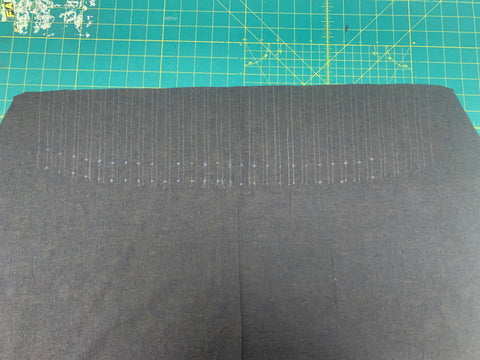
With wrong sides together, I folded along all the pleat lines lines with dots; bringing folds to meet the second line, in the direction of the arrows. I pin-basted the pleats lengthwise from the top edge to bottom dots. This will helped keep everything together. The pleats fall away from Center Back and Center Front.

 Original pattern neckline template on my front.
Original pattern neckline template on my front.
 Here I chalked a new cutting line, 1" above the template neckline. Note that by doing this I added to the shoulder of the pattern too. I could have made the chalk line go toward the original shoulder line, but I liked my pintucks too much, I guess.
Here I chalked a new cutting line, 1" above the template neckline. Note that by doing this I added to the shoulder of the pattern too. I could have made the chalk line go toward the original shoulder line, but I liked my pintucks too much, I guess.



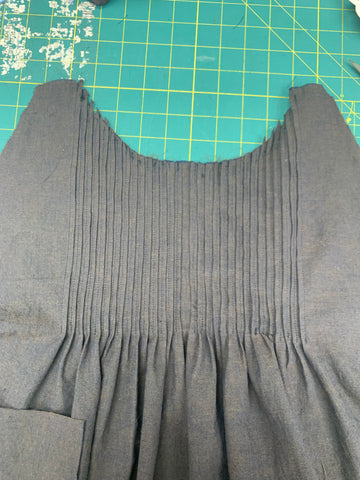

This pattern has clever ways of covering the seams around the sleeves and neckline.





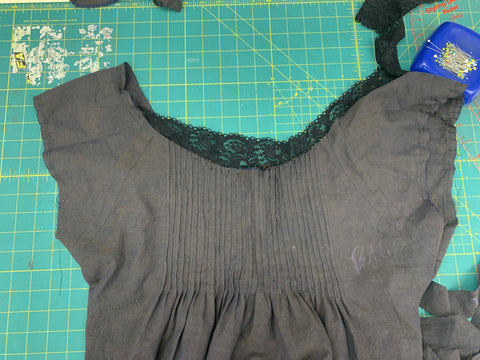

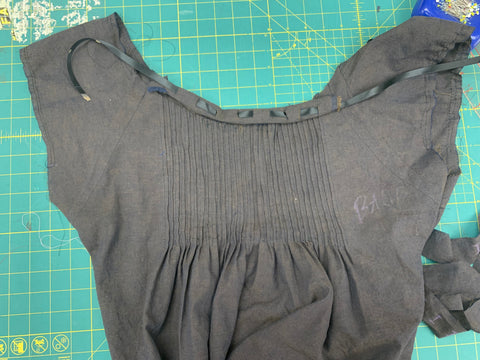



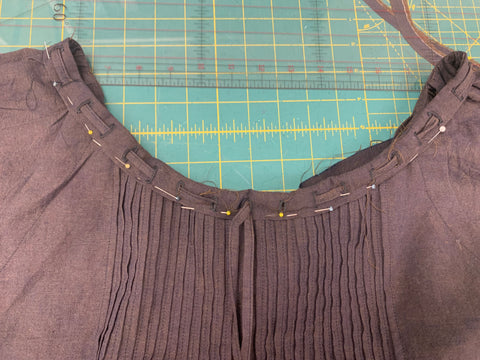




 My finished fabric ribbon.
My finished fabric ribbon.





October 21, 2023 1 Comment on Folkwear's Fall Fabric Collection
by Esi Hutchinson
Folkwear has just gotten new fabrics in from Merchant & Mills, and already had a great collection of some fine wools -- all that are perfect for fall sewing. Molly and I are super thrilled about these fabrics that Folkwear just purchased. The colors blend so well together and compliment the beautiful hues of fall. I just had to show off some of Folkwear's fall fabric collection in a blog post!
I hope these inspire you to make something beautiful for yourself or a loved one. It's always exciting getting new fabric!
First is this soft cotton and linen blend in a teal and tan gingham. A versatile cloth that is a great alternative to linen. This fabric would be gorgeous for pattern such as 121 Guatemalan Gabacha, 123 Austrian Dirndl, 142 Old Mexico Dress, 210 Armistice Blouse and others.

Then, we have a lovely sky blue and peachy-orange gingham. This Indian cotton is very soft and lightweight and would work great for tops, shirts, and dresses. 271 Sunset Wrap, 117 Croatian Shirt, 107 Afghan Dress, 212 Five Frontier Shirts, 121 Guatemalan Gabacha and more.

We love this fine organic cotton twill that has a soft sanded finish on one side; in a beautiful classic Ecru color. Perfect for patterns like 229 Sailor Pants, 240 Rosie the Riveter, 231 Big Sky Riding Skirt, 230 Model T Duster as well as other pants, skirts and lighter weight coats and jackets. We also have this fabric in two darker shades (Sand and Tan) as well as Brick.

This is a beautiful plaid Indian Cotton in a sweet orange and pale sour blue. This would suit patterns like 131 Tibetan Chupa, 119 Sarouelles, 107 Afghan Dress, 112 Japanese Field Clothing, and 201 Prairie Dress.

I think this great black and white check cotton fabric fits the fall theme of plaid prints in a deep hue. Use it for patterns like 121 Guatemalan Gabacha, 270 Metro Middy, Basics Pinafore, 117 Croatian Shirt, and 222 Vintage Vests.
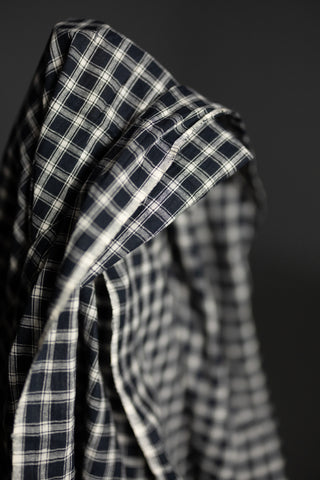
I love this cotton/linen blend and I can't wait to make a dress from it. It is a soft fabric in a medium to light weight with navy blue and white skinny stripes. A versatile cloth that is a great alternative to linen. It would look beautiful for 102 French Cheesemaker's Smock, Basics Pinafore, 112 Japanese Field Clothing, 123 Austrian Dirndl, 210 Armistice Blouse, 203 Edwardian underthings, and would be suitable for other dresses, tops, shirts, skirts, and loose fitting pants.

October 19, 2023
by Molly Hamilton
The cloche hat became popular in the 1920s. It was originally designed in France a decade or so early by milliner Caroline Reboux, and is named with the French word for "bell" because of its typical shape. The cloche generally features a small brim or no brim and was perfect for the new short women's hair styles of the early 1920s. It's popularity surged in the 1920s with new fashions and freedoms. The hat was a huge departure from the wide-brimmed hats that were popular in the previous era, and reflected the changing fashion trends and newfound liberation of women. The cloche hat continues to be a symbol of femininity, style, and the bold spirit of the 1920s.
Folkwear's 262 Spectator Cloche hat comes from the 262 Spectator Coat pattern, and features a wide cuff that is perfect to embellish with embroidery, applique, or other trims. It can also be made from a separate coordinating or contrasting fabric or left off entirely. We recently released this hat as its own PDF pattern!
In this blog post, I am going to show you how I made the basic cloche hat. I also made a fabric flower to trim the hat and will share some tips for making one yourself. You can find instructions for making a fabric flower in this blog post.
Choosing Fabric
We have made three cloche hats in this office in the last several weeks, and each one was made with a different fabric. In general, you want to use a medium to heavy weight fabric to make a hat that holds its shape. I made the one for this post with a navy heavy weight wool blend from our collection (top photo). This fabric was perfect for a warm hat that is also sturdy. Esi made one with a cotton canvas and several layers of voile, which you can see in this post about making the 262 Spectator Coat.
And I made another that I hope to show off soon out of a lighter weight wool that we also have in stock - this vicuna wool. The photos below show the hat while I was working on it. I made the hat without the cuff and added a band of fabric that I added a ruching style to (from 123 Austrian Dirndl) and had pinned onto the hat to see how it looked. You can see the hat without the cuff, then with just a band of fabric, then with the ruched fabric. Which do you like best??




The possibilities for this hat are almost endless!
For the lining, a soft lightweight fabric is best. Think Bemberg, silk, satin, charmeuse, rayon, cotton voile. I used a navy cotton voile for the lining of this hat. Esi used a rayon/linen blend, and I used a scrap of silk charmeuse for my other hat. All were great!
Sizing
The hat comes in sizes XS to XL, which finish at 22½” (57.2cm) to 24-1/2" (62.2cm), respectively (measurements are in the pattern). However, this hat is cut on the bias which means that there is some movement or stretch that is built into the hat. You can adjust the inside ribbon band to make the hat larger or smaller by about 1/2" in either direction for whatever size you choose. So pick the size that you think works best for your head size (measure around the crown of your head), and adjust at the end of the hat making, if needed. I made my hats in size small and they fit great and did not need any adjustments. Esi made her hat size large to have more room for her hair and she was happy with that size also.
Cutting out the Pattern
For the cloche, you will need to cut one hat cuff, one hat front, and two hat backs from the main fabric and from the lining fabric. Be sure to cut the two back pieces so that they are opposites (i.e. if cutting one layer of fabric, be sure to flip the pattern piece print side down to cut the second one).
Sewing the Cloche
It is important to note that this hat pattern has a 3/8" seam allowance. This is to reduce bulk in the hat seams.
First, it is important to transfer the pattern marks to your fabric. For my wool blend hat, I decided tailor tacks would be the best way to mark the pattern. These are easy to remove and do not leave any marks that I have to wash out. Also my fabric was dark so I would have needed a white or light colored marking tool. I did not want to scrub or brush chalk out. Anyway, tailor tacks were perfect. To make tailor tacks, I used white thread and with a needle pulled the thread through the fabric at the mark on the pattern. I clipped the thread so that it marked on my fabric where the dots were located.

On the front pattern piece, I made the darts indicated on the pattern, sewing from the top dot to the dot at the bottom of the dart, with right sides of the fabric together. At the bottom of the dart, I sewed right off the fabric, cut the threads long and tied them by hand so I did not have backstitching at that point. At the top of the dart (top of hat), I backstitched to secure the thread. I matched the dots (not squares) at the top of the pattern, which I marked in the photo below with red dots so you could see it clearly. The other thread in the photo indicates the square at the top of the crown that we sew in the next step. This is important to note and make sure you sew the correct parts to make the darts. I sewed both darts on the hat front in this same way.


Now I sewed between the dot and the square, which I marked with a tailor tack - so I sewed the remaining seam at the top of the hat from my stitching (also marked by a tailor tack in the photo) to the other tailor tack. You can see how it is marked in the photo below.

Next, I sewed the same type of dart at the top of the back hat pieces. And, then sewed the small dart on the center back of each back piece. I marked the smaller dart line with red in the photo below so you could easily see where it goes. This one is a little tricky because it is so small, but it just needs to be marked clearly. I marked the start of the dart with a pin and sewed to the tailor tack.

Once the darts are in the hat back pieces, I sewed both back pieces together at the center back seam, with right sides together. I made sure to match the two dart seams that come together at the center back.
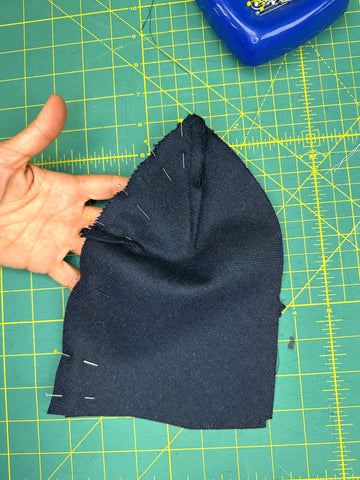
Now I was able to sew the front and back of the hat together. At the top of the hat, several seams come together to create some bulk, but you can a seam jumper to help you get over the fabric hump. My seam jumper is just some plastic pieces that you use under the presser foot to keep the foot level even when it is going over bulky seams. You can barely see my seam jumper below just behind my presser food.


Front and back of hat pinned together.
I did all the same steps for sewing my lining pieces as I did for my main fabric pieces. I have a little tip for sewing the lining darts, or really starting any seam on very fine fabric like like fine cotton voile or silk. I use a scrap of tracing fabric under the seam. This gives the fabric stability and keeps the fine fabric from getting pulled into the feed. After the seam in sewn, I just rip the tracing fabric off and I'm left with a nice seam.

Starting my seam with a scrap of tracing fabric under my lining fabric to keep the fine lining from getting pulled into the feed.

Main fabric and lining ready to be put together.
Next I sewed the cuff of the hat by sewing the center back together on the main fabric and lining. Then I put the cuff lining and main fabric together with right sides together and matching notches and center back seam.

I turned the lining to the inside and pressed it so that the outer fabric was about 1/4" to the inside (so the lining would not show on the right side).
And then placed the lining inside the main part of the hat with wrong sides together. I basted the open edges together so they could be sewn without shifting.


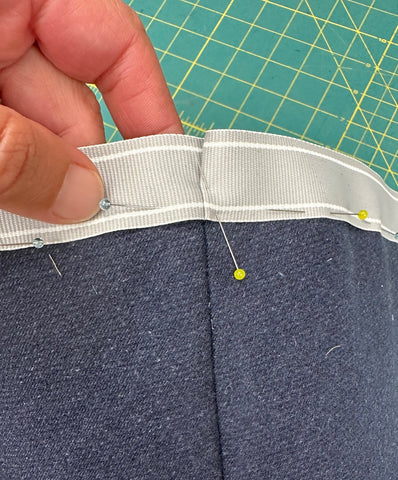
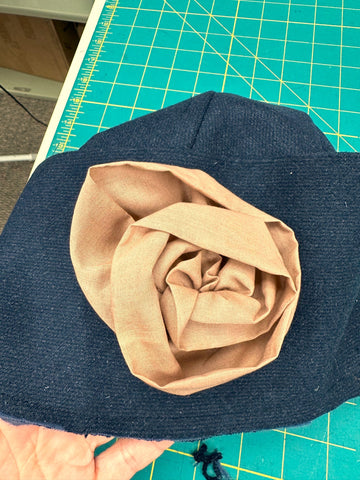
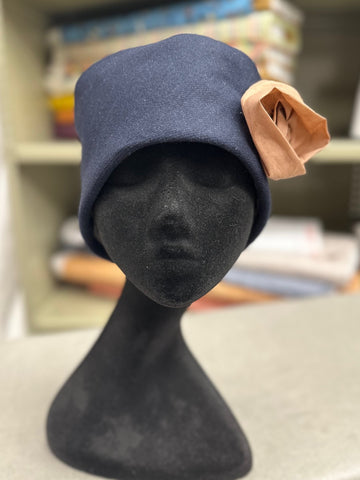


Back of cloche on a hat form.


Cloche hat on me. It is quite warm!
Now, what hat are you going to make? What trim would you add to it? What other questions do you have about this hat? There are so many options! We would love to see what you make with this pattern!
October 15, 2023 5 Comments on A dress from 117 Croatian Shirt pattern
by Molly Hamilton
I have had a vision of making the 117 Croatian Shirt pattern into a dress for several years. I even bought the fabric I wanted to make it in and cut out the pattern. I just didn't get around to it until this summer. Sometimes I have to stop what I feel like is important work, like making new patterns, and work on what I want to work on, which might be doing something creative for myself. I also think it is important to focus on the amazing and wonderful old patterns that Folkwear has in its collection. These are truly unique and interesting patterns and I love working with them to make something new.
This summer I was cleaning out fabric and found this beautiful European linen I had bought from Merchant and Mills. It is a linen similar to this one, but mine was an autumn orange-brown. And I remembered I had bought it for making the Croatian Shirt which I wanted to be long enough to wear in the fall as a dress. I stopped what I was doing and started on the dress. The shirt pattern actually has two lengths marked on the pattern - one to make a shirt and one to make a mid-calf length dress. I shortened the dress-length to hit a little above my knee after it was hemmed, and cut out the pattern.

I was a little intimidated by the pintucks in this pattern, but slow and steady, as they say, and they came out fine (but not perfect). There are also a lot of pleats in this pattern - at the shoulders, neck, and cuffs - but giving each a little clip, as the pattern indicates, makes them very easy to manage. I also noticed that the number of pleats at the shoulder was incorrect in my paper pattern and I adjusted them to seven and centered them (this correction has been made in the PDF pattern).

I would not suggest using a linen of the type I used if you are wanting crisp pintucks and pleats. The linen relaxes and does not stay crisp. It also doesn't love to stay perfectly straight for making pintucks. But it was exactly the look I wanted.
 You can see the back and shoulder pleats here (dress is on a hanger for this photo!).
You can see the back and shoulder pleats here (dress is on a hanger for this photo!).
I had finished making the pintucks on the front of my shirt piece when I headed off to drive to Canada with my children. So I decided to use some of my travel time riding in the car (my oldest drove some of the way), making the honeycomb on the pintucks. This technique was easy and interesting and went fairly quickly. I got one side done in an hour or so riding in the car on the way to Canada, and the other side done on the way riding home. I used a slightly contrasting dark brown buttonhole thread to make the stitches. I liked using a thread that could be seen but was not as thick as perle cotton, and liked the contrasting color rather than using a matching color.

I found some buttons in our stash at the office that worked quite well to finish the project. I also like the curved cuff (and collar) on this dress. These little details make it a special piece.

I love how this 117 Croatian Shirt dress turned out! It is exactly what I was hoping for - a perfect fall-colored, cool-weather dress that I can wear with boots for now and add leggings or tights as the weather cools further. It is comfortable and pretty, and I love wearing something that has some history behind it.

October 12, 2023 1 Comment on 262 Spectator Coat in Toile
By Esi Hutchinson
In the 1920's coat fashion shifted towards loose, straight, and undefined waistlines. Coat details, such as cuffs, collars, and pockets, were enlarged with options for contrasting fabrics and decorative embellishments. View A of our 262 Spectator Coat, based on a coat from 1925, is very typical of this 20's style, featuring a sweeping cape collar, big sleeve cuffs, and large rectangular pockets.
In this post I will show you how I made a version of View A of the Spectator Coat. I made some modifications, mainly to the construction of the pattern, that is slightly different from the original construction. I made a more informal, less tailored, coat without shoulder pads, sleeve heads and interfacing. However I do think referring to the "Professional Tips for Sewing Success" that is included in the pattern is very helpful. These Tips teach how to make your own interfacing and shoulder pads from Hair Canvas is really interesting. Hair Canvas gives the garment a more structured shape but without the stiffness of interfacing we have now. Cotton batting, fleece, and flannel can also be used to make your own shoulder pads and sleeve heads. But I did not do any of this for the coat here.
I picked View A of this pattern because I love the dramatic collar -- it's like a cape and it feels empowering. 266 Greek Island Dress, 270 Metro Middy Blouse (which was the first Folkwear pattern I used), 211 Two Middies, and 150 Hungarian Szur all have large collars and I really like them all.
For me, making this coat was actually a very simple assembly process, not tricky at all. This pattern may look intimidating but it comes together quite easily. I hope this post helps you also find that this coat is not nearly as intimidating as it looks at first.
Lets talk about fabric options!
Medium to heavy weight fabrics are suggested for this coat. Silk and cotton velvet would look very luxurious, twill or wool for a more casual look. Boucle (fabric made from looped yarn) and corduroy (make sure you choose a layout with nap) would be great as well. And check out our fabric suggestion post for this coat.
I used a medium-weight, blue and cream French toile cotton canvas as the main fabric for my coat. It's not fabric designed to be very warm, but this jacket is meant to have layers worn underneath and I thought this fabric would be a lot of fun to use to make a coat from. It is perfect for the informal-looking coat that I had in mind. We actually have this fabric in our shop now!
For the lining, we suggest a medium to light weight fabric like silk, cotton, or rayon. If your main fabric is quite thick or heavy-weight, use something lighter such as a cotton voile, silk, or Bemberg. I used an off-white cotton linen blend for my lining. It complemented the cream in the toile of my main fabric, and it was a little lighter weight than the canvas of the main fabric. You can also find the fabric here in our shop.
For the cuffs, collar, and pockets, you can choose anything from contrasting fabrics to complimentary, or use your main fabric. Faux fur would be really fun and fitting for the 20's era for the collar and cuffs. Boiled wool, jacquard, satin brocade, suede, leather and medium weight silk are also great options for contrasting fabrics. Usually you want a fabric of similar weight as your main fabric for these details. However, we had a cotton voile in our fabric collection that matched perfectly the blue in the toile of my main fabric, so I went with that. It is lighter weight that you would normally want to use in these details, but it worked very well. I used this marine blue cotton voile.
Another thing to consider when planning this coat and choosing fabric is how you might want to embellish it. The collar, cuffs, and pockets of this view are particularly good canvases for embroidery, applique, and fabric painting. Here are previous blog posts that show how to do some embellishment techniques. Maybe checking these out will help you come up with your own to embellishments for this coat: Chinese Jacket Embellishment, Flapper Dress Embroidery, How To Transfer Embroidery Designs to Fabric, Sewing Designs onto Fabric.
Sizing
Pick your size using the yardage chart, and keep in mind that the coat is not fitted, but very loose. So if your want it to be a closer fit, think about making a smaller size. I made a size Small. View A measures 51"/129.5cm from center back neckline to hemline on all sizes. This is meant to hit about mid-calf, but was low-calf length on me. If you need to lengthen or shorten, do so before cutting your fabric. If you do want to lengthen or shorten, you may need to increase or decrease your yardage of fabric before purchasing and cutting your fabric.
Seam Finishes
Since this pattern has a lining, the only seam finishing you really need to do is press! However, if your fabric ravels, I would suggest that you finish the seams with some type of overcast stitch (serge, zigzag, etc.).
Make sure you press really well (there are tips for pressing in the pattern!). I used to never press while I sewed and now I can't stand it if my seams aren't pressed well at each step. It really makes a difference and the assembly process goes more smoothly.
This was my process!

First I traced by pattern and cut out my fabric. View A has softer lines and a less formal structure than View B. Since I used a canvas fabric, I didn't feel the need to have more structure in this garment. So I did not use interfacing that the pattern calls for.
To start, I marked darts on the wrong side of the front and back pattern pieces, I like to press my darts in place before I stitch. And I tie the darts at the tip rather than back stitching to secure in place.


I sewed the shoulders together.

Easy seam finishing, just press seams open.


If you are embellishing the collar with applique, decorative embroidery, or any other techniques (which I would love to see someone do) do so now on an interfaced Collar piece. The interfacing here for embellishments is important to provide stability for the fabric.
Since I used cotton voile as my contrasting fabric, I doubled my voile for more opacity (since the voile is semi sheer) and stability.

If you are using three layers, as I was, it is probably wise to baste the layers together along the outer edge before assembling, just to keep everything together and neat.

I trimmed the outer seam allowance and clipped into and cut notches out of the seam for a for the fabric to lay flat when turned right side out.

Then I basted the Collar neckline edges together.

I basted the collar to the coat neckline edge between the squares, with non-interfaced collar toward coat if you are using interfacing. I was not using interfacing, so I placed the outer fabric (not my contrasting fabric) toward the coat.
I did not have any trouble matching the notches on the collar to the coat Center Back and shoulder seams. Depending on your fabric stability, you may need to clip along the coat neckline as needed to fit collar smoothly. Another good tip is to hand baste the collar onto the coat before stitching with a machine. This allows you to adjust it and not worry about pins when you are sewing.
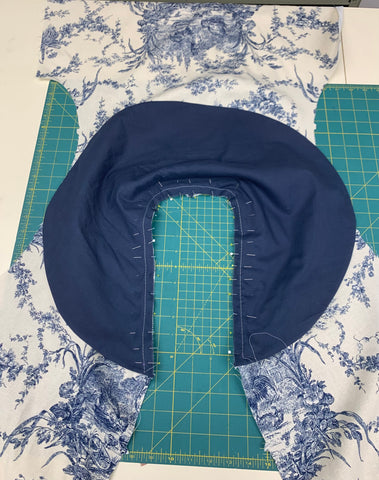
Next, I made button loops.
To make button loops, cut a bias strip of coat fabric 1-1/2” x 10” (4 x 25.5cm). To cut on the bias is to cut at a 45 degree angle from the selvage which is the grain direction of the fabric.

Fold strip in half lengthwise, and make sure to press. You want this piece to be pressed really well before sewing because it makes it much easier to sew. I used lightweight fabric for this, and it might have been a good idea to interface my bias binding to make them more sturdy.
With right sides together, stitch 3/8” (1cm) from raw edge and trim close to stitching. Turn right side out and press. Use a loop turner, bodkin, tube tuner, or even a safety pin and string could work.
Cut the strip in half.

Like folding a paper airplane!
To form loop, fold each piece in half, bringing seamed edges together. If your fabric has a mind of its own, do like the instructions say to maintain loop’s shaped end and make a few invisible hand stitches through seam edge at 1/2” (1.25cm) from end to ensure that folded end of loop protrudes beyond button.

If you already know the buttons you will be using, adjust the length of the loops to fit buttons and baste in place along seamline. I didn't know what buttons I was going to use, so I just adjusted the button positioning when I finally pick some out.

Again, I staystitched along the neckline edge of the coat facing.

 .
.

I also understitched the seam allowances to the facing to keep seamline from rolling to the outside. To understitch, always press the seam allowance toward the lining or facing and stich to about 1/16"-1/8" (1.6-3mm) from previous stitching, or seam line.
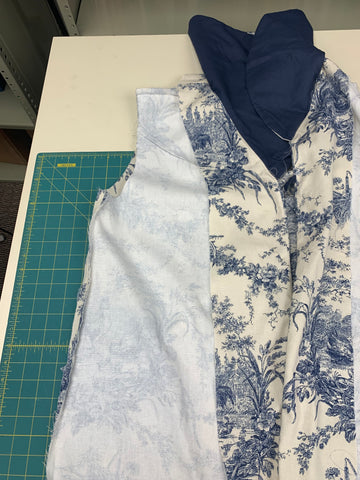
For the sleeves, if you want more structure, baste or fuse sleeve cap interfacing to the sleeve caps. Again, I didn't feel the need to do this with the soft, more gentle, look I was wanting from my coat.
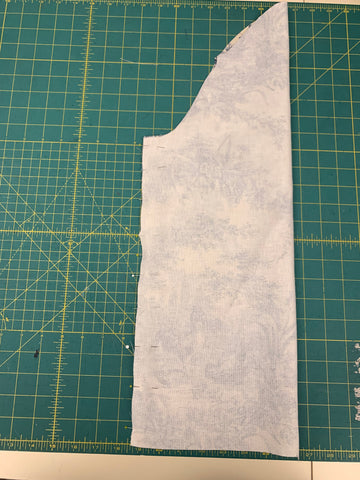 I wanted the lining of my cuff to be my outer fabric and the solid blue to be the outer cuff. I used two layers of the cotton voile again for the outer fabric for the cuffs and pockets.
I wanted the lining of my cuff to be my outer fabric and the solid blue to be the outer cuff. I used two layers of the cotton voile again for the outer fabric for the cuffs and pockets.


I like how the cuff is assembled to the sleeve. It makes the lining assembly look more professional. It was a good tip to turn up the cuff 1/2” (1.25cm) from seam so that seam is tucked inside sleeve. This seam was eventually covered by the coat lining.

I really like this fabric combination!

Pressing up the hem of this coat has can be difficult since it is so wide. I used a ruler and marked the hem length on the right side of the fabric so I could see the hem line easily when I pressed towards the wrong side. Here I measured up 3" (7.6cm) from the edge to create my hem for the outer fabric.

I followed the steps of the lining as instructed and finished the coat.
 Lining of my coat inside out on the dress form.
Lining of my coat inside out on the dress form.
This was a great project with very clear pattern instructions which were easy to follow. I'm really happy with how this turned out, and I think this fabric combination is beautiful. I see that toile is making a comeback again as a trendy fabric to use in garments.
I also made the cloche hat that comes with this pattern! I used the doubled-up voile for the hat cuff and the toile for the main part of the hat, and lined the hat with the scraps from my coat lining. It was a quick project that took very little fabric.
We would love to see what you make with this 262 Spectator Coat pattern! Show us your rendition and fabric combo for this coat in either view.

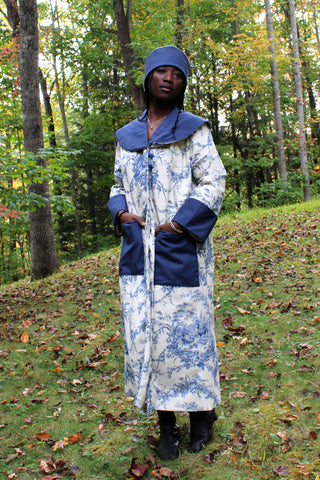


October 06, 2023
It's getting to be that time of the year again . . . Coat Season! Our featured pattern this month, 262 Spectator Coat, provides and encourages many customizable possibilities for both views - including embroidered applique, hand painting, and contrasting fabrics. When it comes to long coats, the right fabric can make all the difference. Fabric can make a statement, can provide varying degrees of warmth, can make a coat feel formal or informal, and on and on.
Below are some of our current fabric suggestions for the 262 Spectator Coat. These fabrics are also great for the hats. And we just released the hats as their own separate PDF patterns - the cloche and the turban. You should also think about trims and embellishments or contrasting fabrics to use for the collars, cuffs, and hats when looking for fabric for these coats and hats.
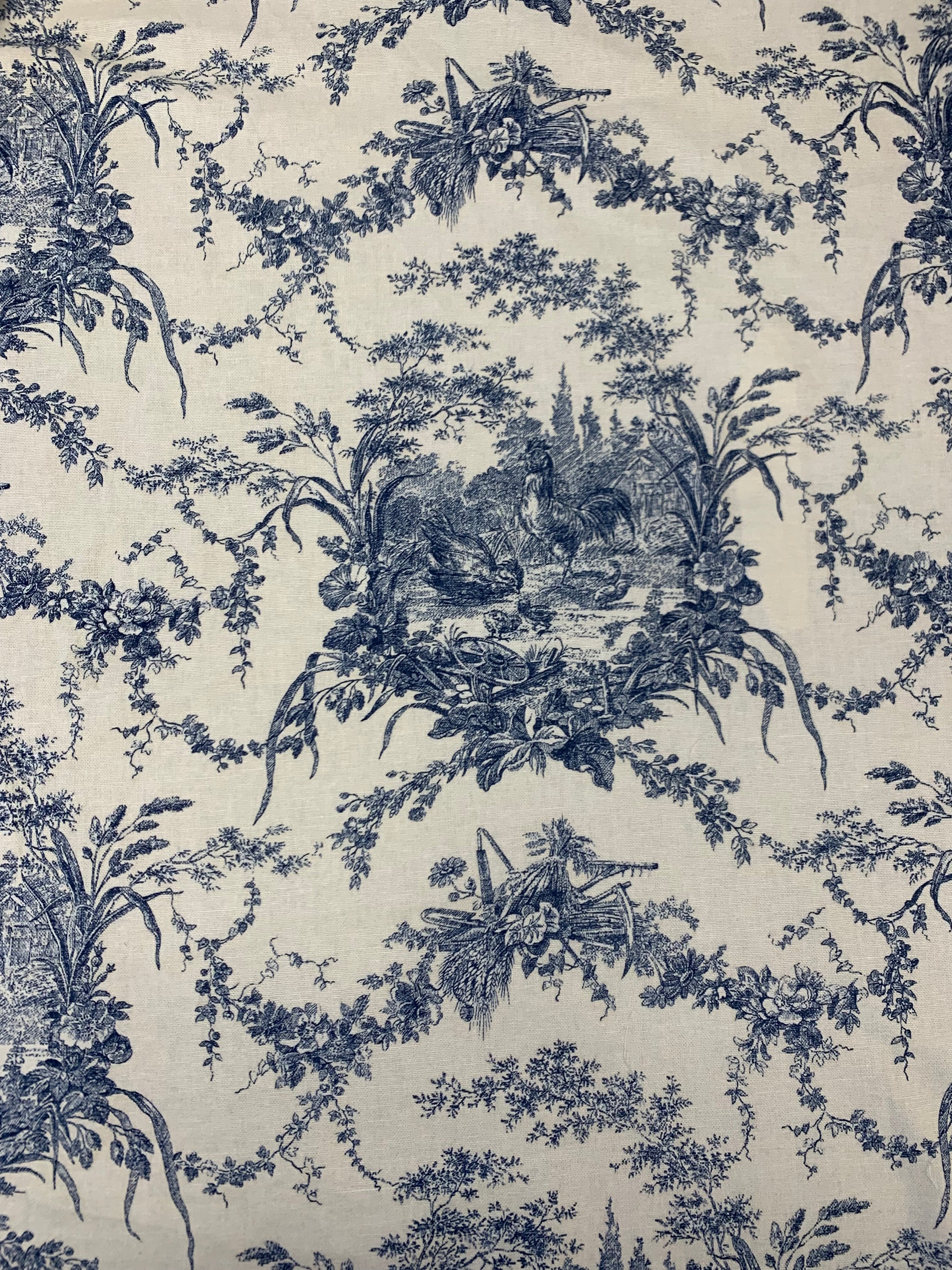
This cream French toile print is a cotton canvas in our own shop. It has a plain-weave with a soft hand, durable and sturdy with a midweight feel. Perfect for a light weight coat for fall and spring - a bit of a statement print (and right on trend) for an informal coat. Love those chickens!

I like this Nara Homespun collection from Harts Fabric features thick cotton fibers woven together in an old-fashioned style to create a sturdy fabric with a stiff drape, which will add to the structure encouraged for the coat. This fabric has a beautiful chrysanthemum design and has a similar color scheme as the French toile above. I think this fabric is pretty and is definitely a statement. Again, great for a lighter weight, informal coat.
This light to medium-weight woven wool woven in a pretty vicuna (light brown with orange undertone) would be a great for the main fabric for one of the coats. The plaid Italian wool below would go really beautifully as a contrasting fabric giving it a casual and vintage look in my opinion. Both of these fabrics come from the Folkwear fabric collection.
Oak Fabrics has some beautiful wools, and this pink wool blend coating is similar to the fabric of our sample above. Add applique and embroidery like the sample or use a contrasting (or complimentary) fabric for the cuffs and collar. We love pink, so this one stood out, but Oak Fabrics has some great wools.
This navy wool blend (mostly wool) is heavy weight and perfect for a classic warm wool coat. This would also be a great canvas for applique or other embellishments, and would work well with contrasting fabrics. This wool comes from Folkwear's collection.
Check out all of Folkwear's wool options here.
Bolt Fabric Boutique has a great little selection of some fabulous felted wools. These fabrics are hard to find and I trust Bolt Fabric to provide high quality fabrics. This lime green felted wool would make a statement coat and would be a great canvas for any embellishments. They also have black for a classic coat, as well as several other colors (and one plaid).
Cotton velveteen makes a great trim for these coats and hats, but it is also priced well enough that the whole coat could be make with it for a luxurious feel and beautiful finished coat. This velveteen comes in several colors at Bolt Fabric.

For something truly decadent, this rayon/silk velvet from Mood Fabrics would be fabulous to make the cuffs and collar and hats of this pattern. You can use these very expensive fabrics for the pieces that don't use a lot of yardage to give your coat (or hat) a luxurious look and feel without breaking the bank. This fabric also gives a period feel to the coat. Of course, if your budget allows, you could make the coat body from this fabric instead. This fabric comes in several colors.
 Brown Bronzed Foiled Faux Fur Fabric
Brown Bronzed Foiled Faux Fur Fabric
For another decadent, and period look, a faux fur would be amazing for the trims on this coat and to make the hats. I liked this brown bronze foiled fur, also from Mood Fabric. There are a lot of faux furs on Mood's site, and I would choose one with a shorter pile for ease of sewing.
So, what fabric(s) would you want to make your Spectator Coat from? Stay tuned for a sew along for View A of this coat where we used one of the fabrics above for the coat!
October 06, 2023
Originally written in October 2020 by Cari.
There is no denying that this Halloween will be atypical since we are still needing to maintain social distance due to COVID-19. I've been contemplating how to celebrate the season myself. I have always loved costuming and celebrating Halloween. So, I don't just want to give up on it entirely this year since there is not a social aspect to look forward to.
And, for the past year or two I've been in a between-phase with a young teen who is almost "too big" for trick or treating, but too young for missing out. We have gone back and forth with going out or staying in. Luckily, we live in an area where whole families participate and adults and kids alike fill the streets on All Hallows Eve. We have alternated between hosting friends (to watch scary movies, play games, and eat treats) and hitting the streets ourselves.
Reflecting on this I have been thinking about how to celebrate this year since gathering indoors doesn't seem like a great option and trick-or-treating is not a given either. It may just be a themed movie night at home this year! I can always enjoy the costumes I see on the screen.
Since we haven't been able to go out to see movies, plays, music, etc in a while; I have enjoyed quite a few movies and TV series at home. I though it would be fun to look at some popular shows and movies that I have enjoyed this year for some inspiration. I often find myself watching and noticing costumes that are "just like" some of the Folkwear Patterns.
I recently got really caught up in Masterpiece Theater's Poldark. The first garment that immediately screamed Folkwear was a cloak much like our 207 Kinsale Cloak! Later in the series the 215 Empire Dress continued to grace the screen.

Cloak image from Pinterest from Poldark

Empire Dress from Poldark on Pinterest
The Peaky Blinders 1920's style is an eyeful. Here is a coat that is so very similar to our 262 Spectator Coat. Gorgeous!
And don't forget the 202 Victorian Shirt, 222 Vintage Vest and 263 Countryside Frock Coat!
Self Made: Inspired by the Life of Madam C.J. Walker features similar menswear mentioned above. There were multiple suits worn by Octavia Spencer as Madame CJ Walker that remind me of our 508 Traveling Suit. There were quite a few references to the 205 Gibson Girl in this film as well.
Also, the costuming of the movie Colette was gorgeous! The split skirt worn by Kiera Knightly when riding a bike and walking in the part is "just like" our 231 Big Sky Riding Skirt.

Split skirt (or riding skirt) which can be worn as pants or a skirt (buttons down the side) is such a clever design!
What are your Halloween plans? Are you dressing up? Do you love to make costumes? What films and shows inspire you?
Let us know!
September 29, 2023 1 Comment on Make the 211 Middy Blouse into a Dress
With fall weather upon us and the promise of much cooler temperatures, change is in the air. Part of this feeling of change comes with the excitement of a change in wardrobe! There is a simple comfort in being reacquainted with one’s old favorite clothes and being inspired to make new favorites as well.
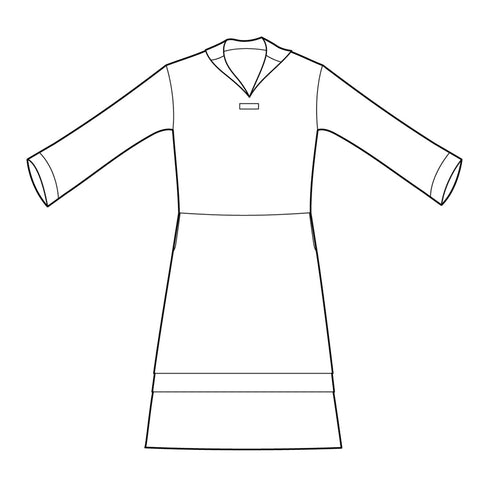
One of the best things about Folkwear patterns is the excellent foundation they provide for making a garment all your own. In this blog post, I am going to show you how I made our #211 Two Middies pattern into a long-sleeved dress!
I turned View B from #211 Two Middies blouse pattern, into a dress perfect for fall! This blouse, with the nautical collar and all its great details, is one of those pieces that is welcome in any wardrobe no matter the season. It is the perfect warm weather blouse with it’s flattering short sleeves and nautical flare. Even if you do not want to make a dress, you can lengthen the sleeves and continue to enjoy wearing the Middy Blouse as the temperature drops. Lengthening the sleeves is easy… just decide on the length you would like and use the “lengthen or shorten here” line marked on the pattern for a warm and cozy version of the Middy Blouse to be enjoyed all winter long. You can also follow along in this blog to learn how.
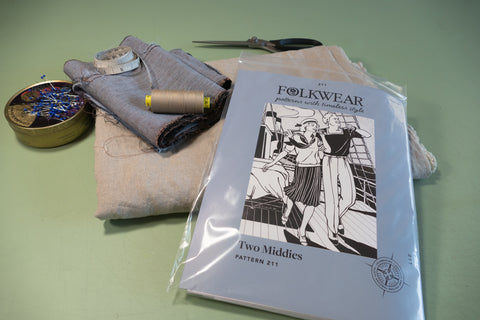
The 211 Middy Blouse pattern, fabric, and thread for making my dress.
The roomy fit of the Middy blouse makes it a perfect candidate for an easy transformation into a comfy dress. The bottom edge of the blouse is made even fuller or wider when the bottom band and little pleats are eliminated. The width of the bottom edge easily accommodates additional fabric for creating a dress.
There are any number of ways of adding a skirt portion to create a dress. The length of the blouse can be shortened or lengthened to change the position of the waistline. It just depends on the look you want and how you want your dress to hang. For a few examples, the blouse could be transformed into a dress by raising or lowering the bottom hem, to create an empire waist or a drop waist or somewhere in between. The blouse and skirt portion could be combined and cut as one piece, or the skirt portion could be added separately with gathers or pleats. For this project, I used the Middy Blouse pattern as it is and simply attached a slightly A-line skirt to the bottom edge of the blouse (minus the bottom blouse band).
I made my dress using View B of the Middy Blouse as my foundation with only a few simple changes to alter the fit that allow for a bit of winter layering and a vintage aesthetic. For example, to create a roomier fit, I simply graded the side seams of the blouse to be wider at the bottom edge. To learn how to grade the side seams of the blouse check out the 211 Two Middies Blouse Sew Along: Day Three. The main consideration is being sure the bottom edge of the blouse is wide enough to easily clear your hip measurement to provide a nice hang and give you enough ease of movement.
The other adjustment I incorporated is to make the sleeves longer. I also decided to make the sleeves just a little bit fuller without having to disturb the armhole construction. To do this, I widened the sleeves slightly from the armhole to the bottom sleeve edge.
The blouse becomes a dress when a simple A-line skirt is added. To give the bottom of the dress a bit of interest I incorporated two horizontal pleats. I also added pockets to the side seams, because nearly all side seams are made better with pockets!
All details on how I made these adjustments are below!
Fabrics
For suitable fabrics, have a look at the blog post Fabric Suggestions for 211 Two Middies. I am using a mid-weight linen with a lovely drape and a scrap of leftover linen cross weave fabric for the collar and cuffs. Check out the fabrics for purchase on our website, where you will find some options for this project.
You will need additional fabric yardage for making the skirt portion and for adding length to the sleeves. I added an additional 1 yard (91cm) for the skirt portion and an extra 1/2 yard (46cm) for the sleeves. The fabric I used was 59 inches (150cm) wide.
Note: If you make length or width adjustments to the pattern pieces, be sure to re-check your yardage requirements before purchasing fabric.
Get Started
You will need to make adjustments to your pattern before cutting your fabric or starting to sew the dress.
Adding Length and Width to the Sleeves
The sleeve can easily be made longer or shorter, depending on your requirements. I decided to add width and length to the sleeves.
If you want to add width to the sleeve, do this adjustment first. I made the sleeve 1/2 inch (13cm) wider by grading the sleeve. To do this, I added 1/4 inch (6.35mm) just to the outer edge of each sleeve side seam, for a total of 1/2 inch (13cm). Remember this sleeve is comprised of a front and a back sleeve piece. Therefore, you do not add any extra width at the connecting center seam. Starting 1/2 inch (13cm) down from the under-armpit seam edge, draw a line connecting to the bottom edge of the sleeve at the added width (in my case at 1/4" wider than the sleeve bottom edge). Use a hip curve to create a smooth connecting line. This is your new outer cutting line for the sleeve. The idea is to widen the sleeve, without disturbing or altering the armhole opening.
After widening the sleeve, I was ready to lengthen it. I decided to lengthen my sleeve pattern to measure 19 inches (48cm) long, keeping in mind the 3/4-inch (1.9cm) cuff to also be added.
I simply cut on the "lengthen or shorten here" line to separate the sleeve into two pieces. Then I inserted another piece of tracing paper behind the two original sleeve pattern pieces, to allow for the increase and connect the top and bottom of the sleeve. Be sure the extra tracing paper is big enough to provide enough overlap on the back side to secure to the original pattern pieces with tape. A bit of tape added to the front side will help as well. Use a hip curve or French curve to create a smooth continuous line connecting the two separated pieces of the sleeve. Trim any access tracing paper away. Now the sleeve pattern has been lengthened and ready to use.
Using Swedish Tracing paper makes this task easy and it can be pinned and reused over and over.

Preparing the sleeve pattern pieces to make a longer sleeve pattern. Notice the graded outer edge.

The front and back sleeve pattern pieces graded and cut apart.

The sleeve pattern pieces separated with more tracing paper underneath to create a new longer sleeve pattern.

The two new longer sleeve pattern pieces.

The new longer sleeves sewn together.
Sidenote: I edgestitched the seams of this dress to add stability to the linen fabric I used. The seams benefit from the stabilization edgestitching provides and this is another way to finish the seam. This is especially relevant if a fabric is not tightly woven (and linen does tend to fray). This edgestitch technique is similar to a faux flat-felled seam, but the seam does not need to be finished together (serged or zig-zagged) so there is a little less bulk in the seam. To edgestitch the seam, press the seams towards the back of the garment and edgestitch on the back side of the seam. I edgestitched the shoulder seams, the sleeve seams, and the waist seam as I constructed the dress. Edge stitching adds a nice finishing detail and strengthens the seams, all at the same time.

The wrong side of the sleeve edge stitched with the seam pressed to the back.

Right side of the sleeve edge stitched on the seam.

The two sleeves sewn together and edge stitched.
Becoming a Dress
I constructed the blouse portion of the dress according the pattern instructions, but left the underarm and side seams un-sewn. It is easier to sew the side seams all at once, after the skirt and pockets are attached.

The blouse portion is nearly complete, except for sewing up the under-arm seams and side seams.
Now to construct the front and back skirt portions of the dress. The skirt I designed is a simple A-line with two horizontal pleats near the bottom to add a vintage touch.
The bottom edge of the blouse determines the width of the top of the skirt portion. The bottom edge of the front and back of my blouse measured 23.5 inches (60cm) wide, therefore the top of the front and back skirt must be the same. I cut the front and back of the skirt with my fabric folded in half, so the bottom edge of the front and back skirt was as wide as my fabric would allow (29.5"/75cm wide or half of the 59"/150cm wide fabric) and the top was 11.75 in.(30cm) at the fold (and 23.5"/60cm when opened).
You can cut your skirt as long (or short) as you want. I wanted my skirt to be a bit longer than mid-calf length, and I wanted to add pleats to the skirt for interest. The pleats meant that I cut the skirt about 4 inches longer than needed, to make two, 1-inch pleats. If you add pleats to your skirt, make sure you make the pleats at the exact same place on the front and back so they match when sewn together.
First, sew the front skirt to the front of the blouse at the bottom hem of the blouse. Then, sew the back skirt to the back of the blouse at the bottom hem of the blouse.
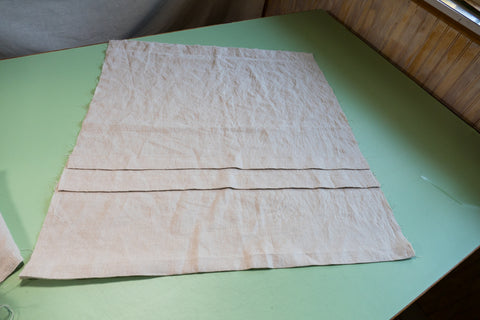
One of the two skirt pieces with its two pleats ready to be added to the bottom blouse edge.

Making sure the horizontal pleats of the skirt align.

The blouse and skirt portions are ready to be assembled.

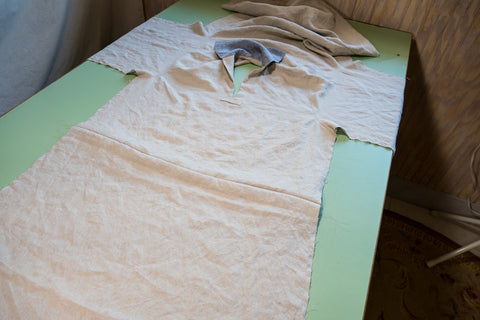
The skirt and blouse pieces sewn together.
Adding Pockets and Sewing the Side Seams
Add the pockets to the side seams of the skirt before sewing up the side seams of the dress. The pockets are optional, but this is a perfect opportunity to try your hand at putting pockets in a side seam. To learn how easy side seam pockets are to make check out the Pocket Series: Side Seam Pocket blog.

Pinning the pocket pieces into the side seams to the skirt side seams.
Stitch the pockets in place first with one pocket piece on the right side of each side of the front and back of the dress. Make sure the pockets are at the same place on each side so they match when put together. Then press the pockets to the outside of the dress and press the seam allowance toward the pockets. Pin the dress side seams and stitch the seam allowance starting the the bottom edge of the dress and sew to the bottom edge of the pocket, being sure to back stitch. Then start the stitching again on the top edge of the pocket and continue up the blouse side seam, pivot at the arm pit and finish stitching at the edge of the sleeve. Then sew the pocket bags together. Repeat for the other side.

The side seam and pocket bag pined and sewn using the seam allowance.
Add the cuffs and little pleats to the sleeves according to the pattern instructions or simply hem to produce the length you require. Binding the sleeve edges would be a nice touch too.
Hem the bottom skirt edge and enjoy your new dress just in time for cool weather!

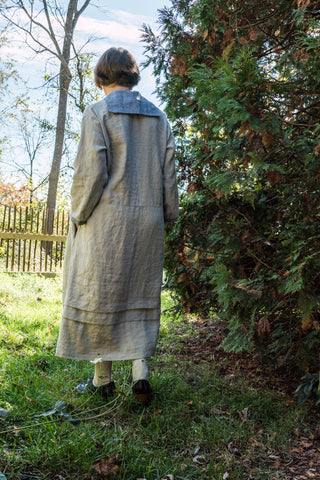

Back view of the Middy collar

Cuff and side seam pocket.

View of the pleat detail.
By using the 211 Two Middies pattern and making some simple changes you can turn this lovely blouse into a whole new wardrobe stable. Learning to look at a pattern with fresh new possibilities is a great way to create new versions of old favorites and enjoy your patterns even more.
We, at Folkwear, look forward to seeing what you are inspired to make!
September 26, 2023
By Esi Hutchinson
Hello and welcome back to our new pattern, 511 Juliette's Dream, a lingerie baby doll dress that comes with two views and in sizes XS-4XL. Today I am going to show you how I made our View B - which has an open front, an unlined bodice with crisscross straps, and a full circle skirt accented with bows on the side seams. Both views of Juliette's Dream can also be made into a casual day wear if wanted, perfect for a spring or summery days - and of course, great for the privacy of home. Find my previous post for a sew along for View A here. In this post, I will go through how I made View B and I will show you how I added a lining for the bodice even though this view has an unlined bodice. This option is good if you don't want to finish the edges with bias tape or edging or if you want more body in the bodice (or if your fabric is sheer and you want another layer).
Fabric and Preparation
This sew along is for View B, has the same fabric options for the previous sew along for View A. This pattern needs fabric that is light and drapey. Use soft and flowy fabrics such as silks like charmeuse, habotai, crepe de chine, or silk synthetics. Cotton voile, lightweight linen, rayon, or rayon/Tencel blends are also great options. Check out our fabric collection we just got a ton of new fabrics added to our beautiful collection. If your fabric is quite sheer you can add lining of the same fabric for this view, but of course a sheer fabric is a great design choice for this pattern.
Always pre-wash your fabric before cutting, unless it is laundered fabric.
For notions, this View only needs bias binding (which I will cover below) and ribbon for the straps and bows. If not lining the bodice, you will need 2-1/2 to 3-1/4 yards (2.3-3m) of 1/2” (13mm) bias binding. If you do line the bodice, you will only need about 1-1/2 yards of bias binding. You will also need 2-1/2 yards (2.3m) of 1/4” (6mm) ribbon or bias binding for straps and another 1-3/4 yards (1.1m) ribbon for bows and ties. You can use slightly wider ribbon, up to 1/2" (13mm) if you prefer. For the ribbon, I suggest something satin or soft. You can also make your own "ribbon" with bias binding - just fold it in half and sew along the edge to close it.
Sizing
Choose the bodice cup size to fit your bust and cut the size that fits best according to measurements in the yardage chart. To find the best cup size, measure your full bust and high bust. If there is a 2” (5cm) difference, choose B cup; if a 3” (7.6cm) difference, choose C cup; and if a 4” (10.2cm) difference, choose D cup. To facilitate cutting out the pattern, mark your size along the appropriate cutting line(s) with a colored marker. The yardage chart also has approximate finished measurements, if that helps you decide which size to cut. I used the size Small for this project.
You may need to adjust the pattern pieces because these are approximate measurements. Making a muslin first is not a bad idea for a perfect fit for you. You can find the finished measurements on the back of the paper pattern or in the PDF pattern.
Seam Finishes
If you are not using a lining for View A , serging, overcasting or zigzag stitching can be used to finish seams if desired, especially for fabrics that fray. Picot the raw edges for the hem; and skirt seams could be finished with a French seam. You could also pink the seams for less bulk and a vintage-style seam allowance.
Learn how to sew a French seam in this blog post.
Cutting Out Your Pattern
Cut out your pattern pieces using the different cutting lines for View B. Remember to also cut lining pieces for Front A and Back B if you want or need it. The pattern indicates to only cut one set of Front A and Back B because this can be an unlined top, but I wanted to line the bodice, so I cut two sets. For View B, you do not need the strap pieces because you are supposed to use ribbon to create the straps. However, if you prefer to have wider fabric straps, you can use the Strap piece and cut two from your fabric. You will use the instructions for straps in View A.
Sewing the Pattern
Bodice
With right sides together, sew center back seam on Back Bodice B, and press the seam open.


With right sides together, sew back to Front Bodice A at side seams, matching notches. Press seam open.

If using a lining, like I did, you should repeat these steps for the lining.
Skirt
With right sides together, sew center back seam on Back Skirt matching notches. Press seam open.

Then, with right sides together, sew Front Skirt E to Back Skirt at side seams stopping at the single notches. Press seams open to notch. Clip the seam allowance to the stitching (but not through) at notches.

Pinned Front Skirt E to Back Skirt F at side seams stopping at single notches
To finish the hem of the skirt, you will create a picot hem. This is a simple hem that can be used on fine and lightweight fabrics to create a tiny, slightly scalloped hem. Use a wide zigzag stitch along hem edge catching the raw edge in the zig-zag to create picot hem. If fabric frays easily fold under 1/8"-1/4" (3-6mm) and zig-zag wrong side up.
You can also hem the skirt with another method if you want - using a rolled hem or turned under hem.

Close up of zig-zag stitch on Skirt hem
Bodice to Skirt
With right sides together, sew skirt to bodice. Finish the seams and press seams toward bodice.

If you are using a lining (like me), sew the lining to the bodice now. First, it will be helpful if you sandwich your straps between the bodice and lining on the front so they are inside the seam of the bodice. You don't have to do this. I did not, and I added the straps later. With right sides together, sew the bodice to lining at the neckline. You will be leaving the front seam allowance open. Trim seam allowance and corners. Turn the lining to the inside and press.

Pinned bodice lining to Bodice outer layer at neckline
Fold under 1/2" (13mm) on bottom edge of Bodice Lining and slip stitching to previously stitched seam leaving front of bodice open, enclosing the bodice hem.
Now, place gathering stitches 1/8” (3mm) from left center front of bodice, catching both layers of fabric if you have lined the bodice.

Close up of gathering stitches at Bodice center front
Pull gathering thread until fabric measures about 2” (5cm) and stitch within the seam allowance to hold. Repeat with right side.

Bias Binding Time!
The front of this View is finished with bias binding. If you are not lining the bodice, as the pattern indicates, you will also finish the neckline with bias binding. Personally, using bias binding is challenging for me. My advice if you also struggle with it is to press really well, and if making your own bias binding try to cut as precisely as you can so you have enough when sewing the binding to the garment. If you want to see an easy way of making bias binding, we have a blog post here and a video on making continuous bias binding here. These tips really help also!
Cut two pieces of your bias to be as long at each side of the front, from neckline to hem plus 1" (2.5cm).
Press open one side of the 1/2” (13mm) bias binding. Sew pressed-open side of bias to wrong side of left garment front. Repeat with right side.

Trim seam allowances to 1/4” (6mm), and fold under 1/2" (13mm) at top and bottom edges of bias binding.

Turn bias binding to right side, folding it over the remaining seam allowance and press.

Press and edgestitch through all layers.

If you are not using a lining, you will sew bias binding to the neckline edge in the same way as the center fronts, trimming and turning under ends of bias so that they line up with the front edges of bodice and raw edges are enclosed.
Straps
My main advice here is to get someone to help you! I would also maybe use string as guides for your final fabric or ribbon so you know how long to cut your straps. Either way, make sure to cut your ribbons several inches (or even 6-12 inches) longer than needed so you can adjust them easily.
Again, you can use ribbon or you can make your own spaghetti straps with fabric or bias tape or binding. Just make sure you have enough length for the straps. Pin two straps to each side of the front bodice where marked on pattern and sew securely to the bodice. The inside straps/ribbons will be about 5” longer than the outside straps/ribbons. The inside straps will crisscross in the back and the outside straps will just go over the shoulder. Adjust to fit the wearer, and pin and sew the straps in place on inside back of garment where indicated on the pattern piece.


All Straps sewn on to Bodice Front and Back
If using straps from View A, follow instructions for View A, and sew in place on inside of the bodice as marked on pattern.
Front Ties, Side Ties
Either make spaghettis from self-fabric or use ribbon and securely sew two 10” (25.4cm) ties to inside of bodice at the waistline and two at inside of the neckline edges on each side of center front, as marked on pattern.

Don't forget to remove gathering stitches if visible.
Using about 10” (25.4cm) of ribbon or spaghettis, tie a bow and hand or machine sew it to garment at the top of the side slit on each side.






